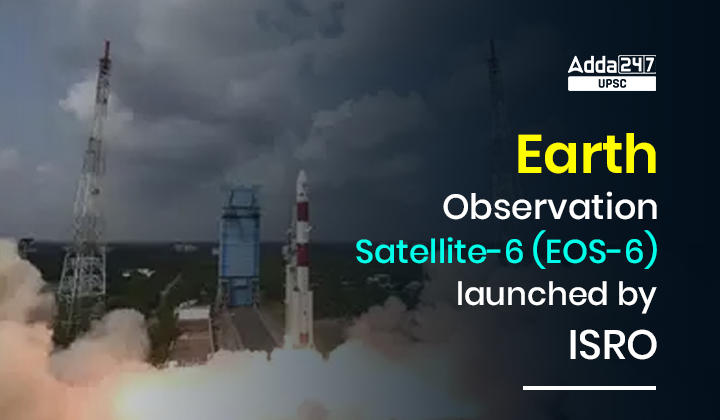Table of Contents
Earth Observation Satellite-6 UPSC Relevance
Earth Observation Satellite-6: EOS-6 is an ocean observation satellite which will help in monitoring various aspects of oceans. Earth Observation Satellite-6 is important for UPSC Prelims 2023 and UPSC Mains Exam (GS Paper 3- Science and Technology).
Earth Observation Satellite-6 (EOS-6) in News
- The third generation Indian satellite for monitoring the oceans, formally named as Earth Observation Satellite-6 (EOS-6) was launched by the Indian Space Research Organization (ISRO).
- Earth Observation Satellite-6 (EOS-6) was launched by ISRO in partnership with Ministry of Earth Sciences (MoES) among others, from its First Launch Pad (FLP) at Satish Dhawan Space Centre (SDSC), Sriharikota.
PSLV-C52/EOS-04 Mission of ISRO
Earth Observation Satellite-6 (EOS-6)
- The ocean observing mission (EOS-06 also known as OceanSat-3) is a follow up to OceanSat-1 or IRS-P4 and OceanSat-2 launched in 1999 and 2009, respectively.
- The EOS-06 satellite was launched aboard the proven launch vehicle PSLV (Polar Satellite Launch Vehicle) on its 56th flight (24th flight of the PSLV-XL version).
Key Details about Earth Observation Satellite-6 (EOS-6)
- The Oceansat-3 was placed in the polar orbit at the height of about 740 kilometers above sea level.
- While at ~1100 kilograms, it is only slightly heavier than Oceansat-1
- Earth Observation Satellite-6 (EOS-6) is carrying three ocean observing sensors viz
- Ocean Color Monitor (OCM-3),
- Sea Surface Temperature Monitor (SSTM), and
- Ku-Band scatterometer (SCAT-3).
- There is also an ARGOS payload.
- All these sensors have their own importance for India’s blue economy aspirations.
Ocean Color Monitor (OCM-3)
- The advance 13 channel OCM with 360 m spatial resolution and 1400 km swath will observe the day side of the earth every day and will provide crucial data on distribution of ocean algae which is the base of the food chain within marine ecosystem.
- The OCM-3 with high signal-to-noise ratio is expected to provide improved accuracy in daily monitoring of phytoplankton having wide range of operational and research applications including fishery resource management, ocean carbon uptake, harmful algal bloom alerts, and climate studies.
Sea Surface Temperature Monitor (SSTM)
- The SSTM will provide ocean surface temperature which is a critical ocean parameter to provide various forecasts ranging from fish aggregation to cyclone genesis and movement.
- Temperature is a key parameter required to monitor health of the coral reefs, and if needed, to provide coral bleaching alerts.
Ku-Band Pencil Beam Scatterometer
- The Ku-Band Pencil beam scatterometer onboard EOS-6 will provide high resolution wind vector (speed and direction) at the ocean surface, something which any seafarer would like to know of, whether its fishermen or shipping company.
- The data of temperature and wind is also very important for assimilation into ocean and weather models to improve their forecast accuracies.
ARGOS payload
- ARGOS is a communication payload jointly developed with France and it is used for low-power (energy-efficient) communications including marine robotic floats (Argo floats), fish-tags, drifters, and distress alert devices useful for conducting effective search and rescue operations.
Significance of Earth Observation Satellite-6 (EOS-6)
- Earth Observation Satellite-6 will provide a bouquet of services every day for lakhs of stakeholders across the nation.
- Ocean observations such as this will serve as strong foundation for the India’s blue economy and polar region policies.
- this is the first major ocean satellite launch coming from India since the initiation of the UN Decade of Ocean Science for Sustainable Development (UNDOSSD, 2021-2030).
- EOS-06 satellite will have the capability to make concurrent measurements of Ocean Colour, SST and Sea Surface Winds.
- It is expected to provide a great boost to the ocean observing capabilities of the global scientific and operational communities in addressing the Ocean Decade objectives and challenges.
EOS Series Launches
- EOS-01: Earth Observation satellite meant for Agriculture, Forestry & disaster management support
- EOS-02: Technology demonstration satellite for various new technologies with applications that include agriculture, forestry, geology, hydrology etc. and forming the payload for SSLV-1.
- EOS-03 : First Agile Earth Observation satellite in Geostationary orbit and applications which include near real time imaging, quick monitoring of natural disasters, spectral signatures for agriculture, forestry etc.
- EOS-04 : Radar Imaging satellite meant to provide high quality images under all weather conditions for applications such as Agriculture, Forestry & Plantations, Soil Moisture & Hydrology and Flood Mapping.
- EOS-05 : Earth Observation Satellite in the Geostationary Orbit.
- EOS-06 : Earth Observation satellite meant for applications, which include ocean related services and advisories towards potential fishing zone forecast , ocean state forecast.
Earth Observation Satellite FAQs
- What is Earth Observation Satellite?
Ans. In 2020, ISRO decided to move to a new naming system for its earth observation satellites which till then had been named thematically, according to the purpose they were meant for.
- How many Earth Observation Satellites have been launched till now?
Ans. A total six Earth Observation Satellites (EOS) have been launched by ISRO, the latest being EOS-06.
- How many sensors EOS-6 Have?
Ans. EOS-06 is carrying three ocean observing sensors viz
-
- Ocean Color Monitor (OCM-3),
- Sea Surface Temperature Monitor (SSTM), and
- Ku-Band scatterometer (SCAT-3).
PSLV-C52/EOS-04 Mission of ISRO
EOS 02 Satellite Will be Launched Later This Year




 TSPSC Group 1 Question Paper 2024, Downl...
TSPSC Group 1 Question Paper 2024, Downl...
 TSPSC Group 1 Answer key 2024 Out, Downl...
TSPSC Group 1 Answer key 2024 Out, Downl...
 UPSC Prelims 2024 Question Paper, Downlo...
UPSC Prelims 2024 Question Paper, Downlo...




